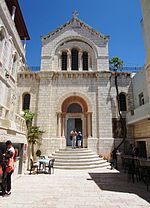Damascus Gate

The Damascus Gate is one of the main Gates of the Old City of Jerusalem. It is located in the wall on the city's northwest side and connects to a highway leading out to Nablus, which in the Hebrew Bible was called Shechem or Sichem, and from there, in times past, to the capital of Syria, Damascus; as such, its modern English name is the Damascus Gate, and its modern Hebrew name is Sha'ar Shkhem (שער שכם), meaning Shechem Gate, or in modern terms Nablus Gate. Of its historic Arabic names, Bāb al-Naṣr (باب النصر) means "gate of victory", and the current one, Bāb al-ʿĀmūd (باب العامود), means "gate of the column". The latter, in use continuously since at least as early as the 10th century, preserves the memory of a Roman column towering over the square behind the gate and dating to the 2nd century AD.
Excerpt from the Wikipedia article Damascus Gate (License: CC BY-SA 3.0, Authors, Images).Damascus Gate
Heil HaHandasa, Jerusalem Morasha
Geographical coordinates (GPS) Address Nearby Places Show on map
Geographical coordinates (GPS)
| Latitude | Longitude |
|---|---|
| N 31.781638888889 ° | E 35.2305 ° |
Address
העיר העתיקה
Heil HaHandasa
9511208 Jerusalem, Morasha
Jerusalem District, Israel
Open on Google Maps









